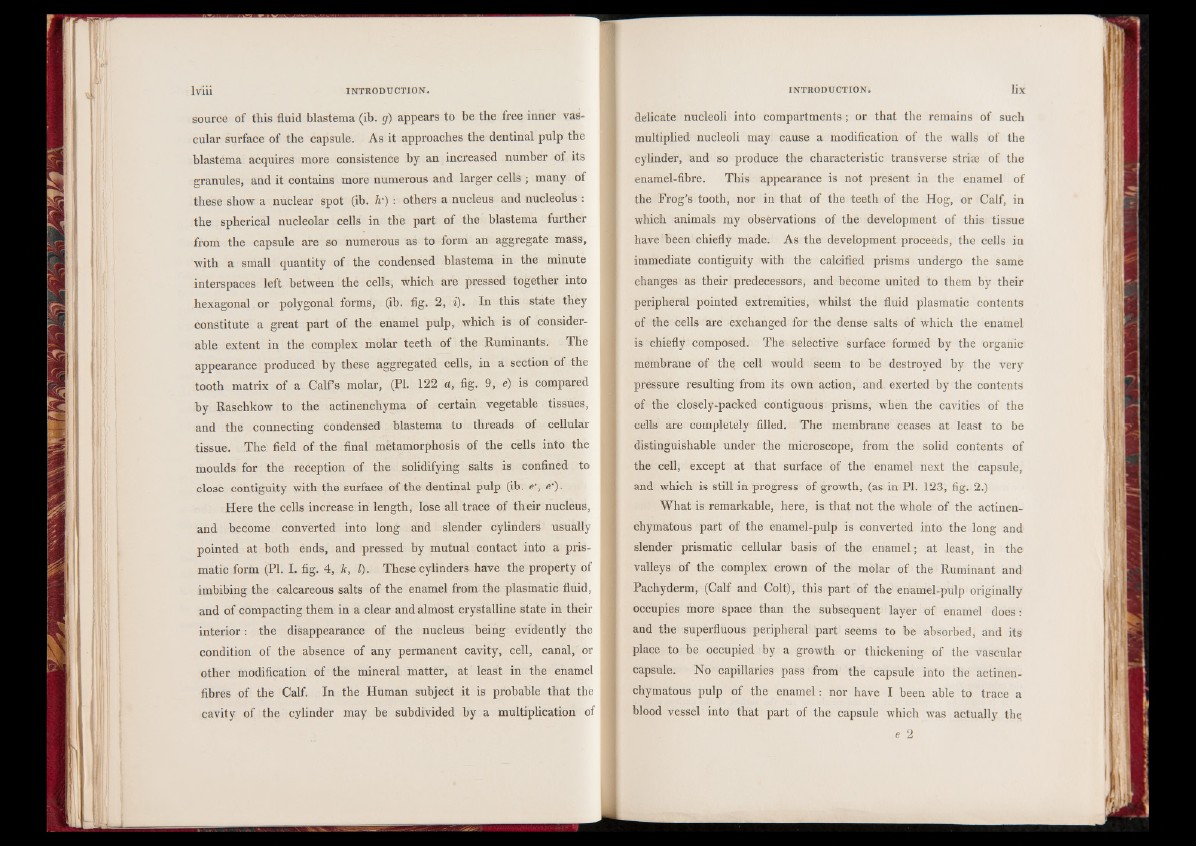
source of this fluid blastema (ib. g) appears to be the free inner vascular
surface of the capsule. As it approaches the dentinal pulp the
blastema acquires more consistence by an increased number of its
granules, and it contains more numerous and larger cells ; many of
these show a nuclear spot (ib. h') : others a nucleus and nucleolus :
the spherical nucleolar cells in the part of the blastema further
from the capsule are so numerous as to form an aggregate mass,
with a small quantity of the condensed blastema in the minute
interspaces left between the cells, which are pressed together into
hexagonal or polygonal forms, (ib. fig. 2, i). In this state they
constitute a great part of the enamel pulp, which is of considerable
extent in the complex molar teeth of the Ruminants. The
appearance produced by these aggregated cells, in a section of the
tooth matrix of a Calfs molar, (PL 122 a, fig. 9, e) is compared
by Raschkow to the actinenchyma of certain vegetable tissues,
and the connecting condensed blastema to threads of cellular
tissue. The field of the final metamorphosis of the cells into the
moulds for the reception of the solidifying salts is confined to
close contiguity with the surface of the dentinal pulp (ib. e•, e').
Here the cells increase in length, lose all trace of their nucleus,
and become converted into long and slender cylinders usually
pointed at both ends, and pressed by mutual contact into a prismatic
form (PI. I. fig. 4, h, I). These cylinders have the property of
imbibing the calcareous salts of the enamel from the plasmatic fluid,
and of compacting them in a clear and almost crystalline state in their
interior: the disappearance of the nucleus being evidently the
condition of the absence of any permanent cavity, cell, canal, or
other modification of the mineral matter, at least in the enamel
fibres of the Calf. In the Human subject it is probable that the
cavity of the cylinder may be subdivided by a multiplication of
delicate nucleoli into compartments; or that the remains of such
multiplied nucleoli may cause a modification of the walls of the
cylinder, and so produce the characteristic transverse striae of the
enamel-fibre. This appearance is not present in the enamel of
the Frog’s tooth, nor in that of the teeth of the Hog, or Calf, in
which animals my observations of the development of this tissue
have been chiefly made. As the development proceeds, the cells in
immediate contiguity with the calcified prisms undergo the same
changes as their predecessors, and become united to them by their
peripheral pointed extremities, whilst the fluid plasmatic contents
of the cells are exchanged for the dense salts of which the enamel
is chiefly composed. The selective surface formed by the organic
membrane of the cell would seem to be destroyed by the very
pressure resulting from its own action, and exerted by the contents
of the closely-packed contiguous prisms, when the cavities of the
cells are completely filled. The membrane ceases at least to be
distinguishable under the microscope, from the solid contents of
the cell, except at that surface of the enamel next the capsule,
and which is still in progress of growth, (as in PI. 123, fig. 2.)
What is remarkable, here, is that not the whole of the actinen-
chymatous part of the enamel-pulp is converted into the long and
slender prismatic cellular basis of the enamel; at least, in the
valleys of the complex crown of the molar of the Ruminant and
Pachyderm, (Calf and Colt), this part of the enamel-pulp originally
occupies more space than the subsequent layer of enamel does:
and the superfluous peripheral part seems to be absorbed, and its
place to be occupied by a growth or thickening of the vascular
capsule. No capillaries pass from the capsule into the actinen-
chymatous pulp of the enamel: nor have I been able to trace a
blood vessel into that part of the capsule which was actually the
e 2